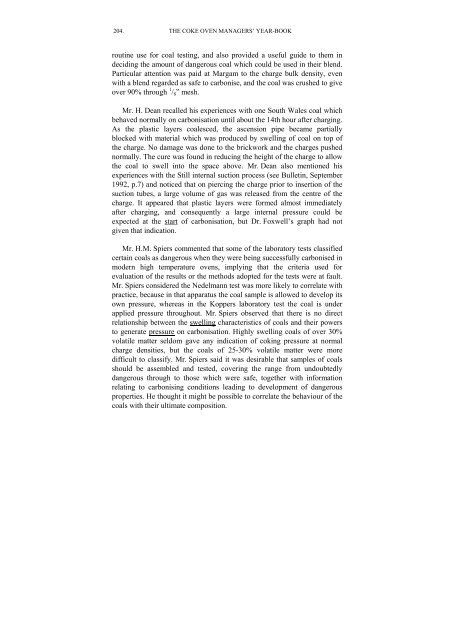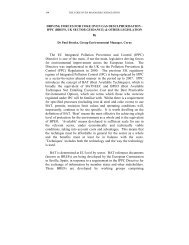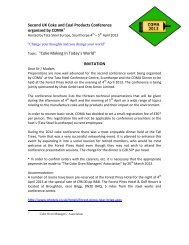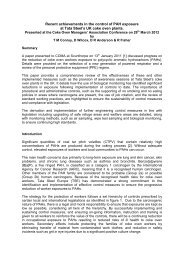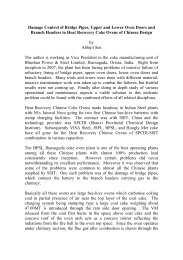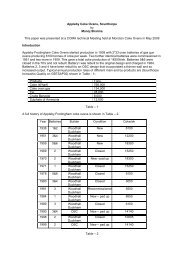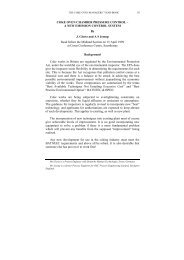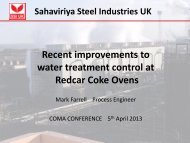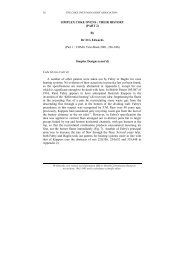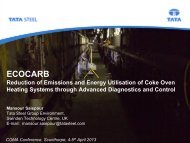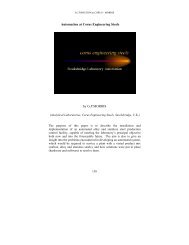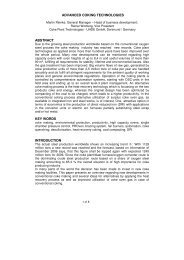CHAIRMAN'S ADDRESS - Coke Oven Managers Association
CHAIRMAN'S ADDRESS - Coke Oven Managers Association
CHAIRMAN'S ADDRESS - Coke Oven Managers Association
- No tags were found...
Create successful ePaper yourself
Turn your PDF publications into a flip-book with our unique Google optimized e-Paper software.
204. THE COKE OVEN MANAGERS’ YEAR-BOOKroutine use for coal testing, and also provided a useful guide to them indeciding the amount of dangerous coal which could be used in their blend.Particular attention was paid at Margam to the charge bulk density, evenwith a blend regarded as safe to carbonise, and the coal was crushed to giveover 90% through 1 / 8 ” mesh.Mr. H. Dean recalled his experiences with one South Wales coal whichbehaved normally on carbonisation until about the 14th hour after charging.As the plastic layers coalesced, the ascension pipe became partiallyblocked with material which was produced by swelling of coal on top ofthe charge. No damage was done to the brickwork and the charges pushednormally. The cure was found in reducing the height of the charge to allowthe coal to swell into the space above. Mr. Dean also mentioned hisexperiences with the Still internal suction process (see Bulletin, September1992, p.7) and noticed that on piercing the charge prior to insertion of thesuction tubes, a large volume of gas was released from the centre of thecharge. It appeared that plastic layers were formed almost immediatelyafter charging, and consequently a large internal pressure could beexpected at the start of carbonisation, but Dr. Foxwell’s graph had notgiven that indication.Mr. H.M. Spiers commented that some of the laboratory tests classifiedcertain coals as dangerous when they were being successfully carbonised inmodern high temperature ovens, implying that the criteria used forevaluation of the results or the methods adopted for the tests were at fault.Mr. Spiers considered the Nedelmann test was more likely to correlate withpractice, because in that apparatus the coal sample is allowed to develop itsown pressure, whereas in the Koppers laboratory test the coal is underapplied pressure throughout. Mr. Spiers observed that there is no directrelationship between the swelling characteristics of coals and their powersto generate pressure on carbonisation. Highly swelling coals of over 30%volatile matter seldom gave any indication of coking pressure at normalcharge densities, but the coals of 25-30% volatile matter were moredifficult to classify. Mr. Spiers said it was desirable that samples of coalsshould be assembled and tested, covering the range from undoubtedlydangerous through to those which were safe, together with informationrelating to carbonising conditions leading to development of dangerousproperties. He thought it might be possible to correlate the behaviour of thecoals with their ultimate composition.


